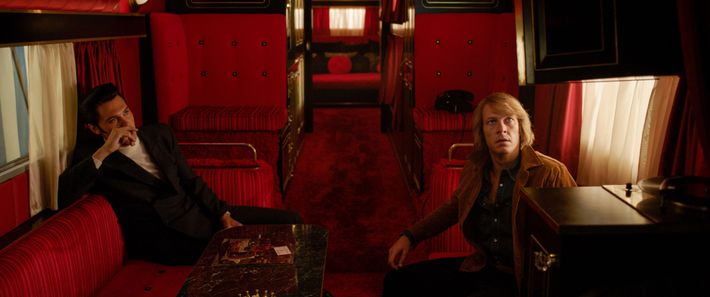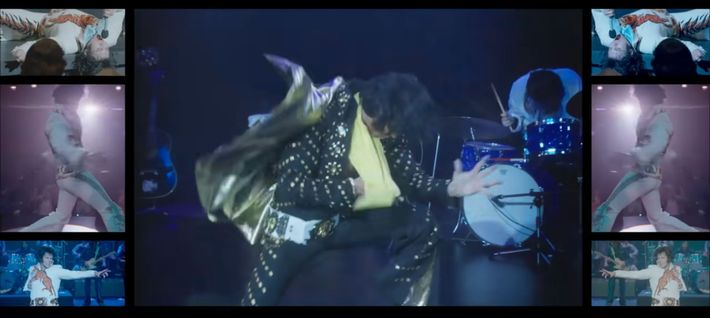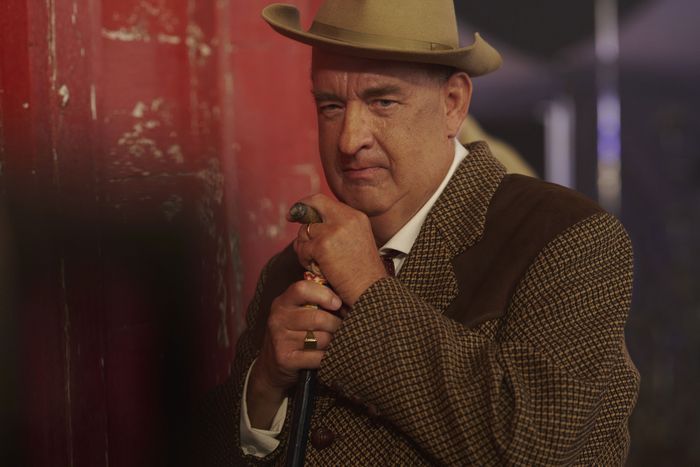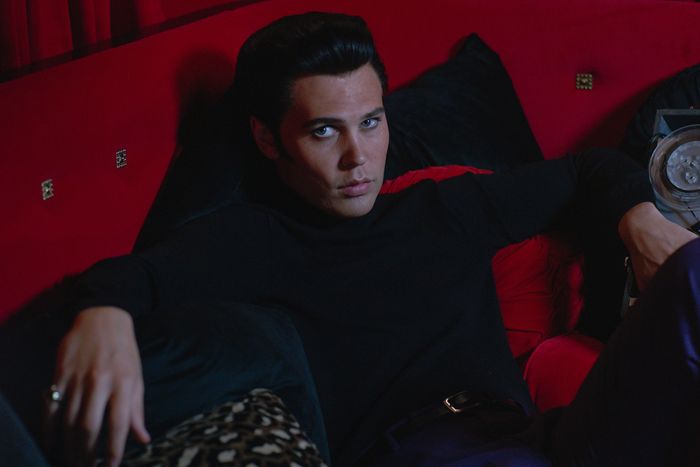
Baz Luhrmann can do many things, but he cannot do less. He arguably sometimes should! But that is like telling Tom Cruise to stop nearly killing himself for our cinematic benefit — it is simply not in his essence. And everything that Luhrmann’s filmmaking is — gorgeous, grandiose, glamorous, garish — coexists in his latest, Elvis.
As Vulture’s own Nate Jones wrote from Cannes, “What I can tell you is that Baz Luhrmann’s Elvis is undoubtedly a Baz Luhrmann Elvis movie.” And while auteur theory isn’t the only way to consider a filmmaker’s career, Luhrmann’s movies are so consistent in look and feel that they always seem born of a singular mind. With that in mind, we’ve tried to answer a simple question: How Baz-y is Baz’s Elvis?
For this rubric, we’ve used some very serious science (read: rewatched some stuff) to provide definitive trends gleaned from Luhrmann’s 30 years as a director and producer. Considered here are his Red Curtain trilogy of Strictly Ballroom, Romeo + Juliet, and Moulin Rouge!; the sweeping and problematic epic romance named after his home country, Australia; his actually very good adaptation of F. Scott Fitzgerald’s masterwork, The Great Gatsby; and the too-soon-canceled Netflix musical series The Get Down. The list below of nine criteria comprise Luhrmann’s go-to moves, favorite flourishes, and stylistic tics to help us determine whether his portrait of the King is his Baz-iest work of all.
1.
An unnervingly handsome lead actor
In Luhrmann’s other work: Consider our first glimpse of Leonardo DiCaprio, set to Radiohead’s “Talk Show Host,” in Romeo + Juliet; Hugh Jackman’s jawline in Australia; Yahya Abdul-Mateen II’s exceptional fits on The Get Down. Luhrmann provides!
In Elvis: Butler’s got the hair, the cheekbones, and the same lightly androgynous look as Leo in the ’90s. He is objectively beautiful, with a lithe, almost feline quality that adds sultriness to the film’s performance scenes. It isn’t quite sexiness, because I don’t think Elvis is all that interested in its subject as someone who experiences lust. (Or maybe we don’t get a sexy Elvis because to do so might complicate the film’s chaste presentation of his relationship with Priscilla, who was 14 when they met.) Anyway, if ruggedness is more your jam, Luhrmann also cast Luke Bracey as Jerry Schilling, a member of Presley’s Memphis Mafia of associates. Yes, the guy from nu! Point Break still exists! Bracey will never be Johnny Utah in my heart, but with feathered hair and a corduroy jacket, he looks pretty good. The handsome-man tally is really working overtime here.
Champagne glass raised for this Baz-ism? Yup! 🥂
2.
Anachronistic music choices
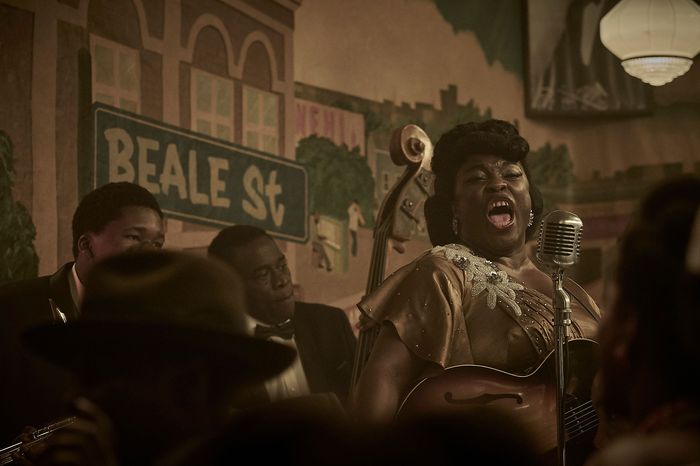
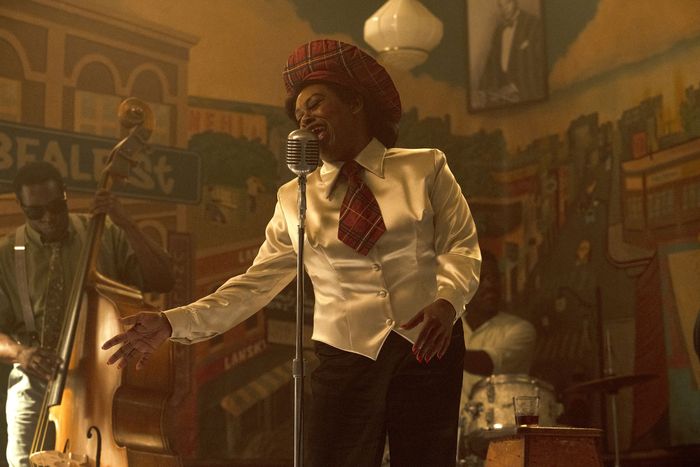
In Luhrmann’s other work: Mashups and covers are a core component of Baz’s soundtracks, which are always top notch. Remember: Quindon Tarver’s “When Doves Cry” cover in Romeo + Juliet, Nirvana’s “Smells Like Teen Spirit” in Moulin Rouge!, the Beyoncé and Andre 3000 version of “Back to Black” in The Great Gatsby, and Janelle Monáe, Nas, and the very catchy “You Can’t Hide / You Can’t Hide From Yourself” from Zayn Malik, Teddy Pendergrass, and Grandmaster Flash on The Get Down soundtrack.
In Elvis: There are covers of Elvis songs by artists including Stevie Nicks and Kacey Musgraves, samples and snippets of Britney Spears’s “Toxic” and the Backstreet Boys’ “Everybody (Backstreet’s Back)”, and tracks that combine present-day performers with classic songs. Rapper Swae Lee and perpetual menace Diplo are credited alongside blues pioneer Arthur “Big Boy” Crudup on “Tupelo Shuffle.” Shonka Dukureh takes on the classic “Hound Dog,” which was written for singer Big Mama Thornton and then became a major hit for Elvis and then Doja Cat adds some flavor of her own to “Hound Dog” and turns it into a partially original song called “Vegas.” Also of note is Yola taking on a couple of songs from the inimitable rock-and-roll pioneer Sister Rosetta Tharpe: “Working On The Building” and “Strange Things Happening Everyday,” both of which are also presented as major influences on Elvis’s sound.
Champagne glass raised for this Baz-ism? Yup! 🥂
3.
Speedups and slowdowns
In Luhrmann’s other work: Perhaps this is easier to show than to explain. It’s this thing Luhrmann does where he speeds up certain snippets of scenes, and juxtaposes them with rapid cuts to mess a bit with our sense of time and communicate characters’ frenzied states. Consider this scene from Romeo + Juliet. Watch how the chandeliers zoom upward toward the ceiling, and how Juliet’s mother gets cinched into her corset and then lights her cigarette.
In The Great Gatsby, dancers move at different tempos at one of Jay’s legendary parties, while Elizabeth Debecki’s Jordan and DiCaprio’s Gatsby walk around in slow motion:
And “Spectacular Spectacular” in Moulin Rouge! is basically this effect as an entire musical number:
In Elvis: Speedups and slowdowns both occur in Elvis, though there’s more of the former than the latter. There’s the onstage moment captured in the gif above. Earlier, as a young Elvis travels along a wooden-plank pathway between a juke joint and a revival tent in the majority-Black neighborhood where he grew up, his movements speed up. And midway through the film, we also get this visual flourish when Elvis is performing at a heavily policed show, after he’s warned against spreading “Africanized culture” via his swiveling hips. (He still swivels, of course, while clad in an all-black, Johnny Cash–like suit and insisting, “In the end, you gotta listen to yourself.”) Slowdowns, meanwhile, focus mostly on Elvis’s crotch and thighs, and the faces of the screaming, entranced female (and male) fans who see them for the first time. Relatable!
Champagne glass raised for this Baz-ism? Yup! 🥂
4.
Split screens, montages, all that jazz
In Luhrmann’s other work: A good example of a Baz-y montage comes in the final moments of Romeo + Juliet, after both the lovers have died by suicide. While they lie next to each other on the church altar, Luhrmann flashes back to happier moments together — their first kiss, their wedding rings — in a bittersweet highlights reel.
In Elvis: In the opening, the screen splits into eight boxes to give us maximum Elvis, and Luhrmann will use that trick a few more times with different numbers of split screens. Montages are everywhere, too: as Elvis performs around the country, as we zoom through his Hollywood acting career, and as we see him get locked into the manipulative Las Vegas contract his awful manager, Colonel Tom Parker (Tom Hanks), coerces him into signing. A Luhrmann montage is about exuberance and excess, and Elvis fits the bill.
Champagne glass raised for this Baz-ism? Yup! 🥂
5.
Great gowns, beautiful gowns
In Luhrmann’s other work: Luhrmann is married to costume designer Catherine Martin, and she has worked as a production designer or costume designer on every one of his films. She won Academy Awards in both categories for Moulin Rouge!, and was nominated for Best Production Design for Romeo + Juliet and The Great Gatsby and Best Costume Design for Australia and The Great Gatsby. She is really very good, and we should thank her for letting Debicki be tall.
In Elvis: The primary challenge for Martin is re-creating and evoking many of Presley’s most iconic outfits, and she does a fantastic job. The black leather suit Butler wears as Elvis during the filming of his not-really Christmas special is impeccably fitted. The spangly belt on his studded white leather jumpsuit draws your eyes to, you know. Those hips don’t lie!
Champagne glass raised for this Baz-ism? Yup! 🥂
6.
A big point about America
In Luhrmann’s other work: Some of them, sure. Luhrmann is no Andrew Dominik, his fellow Australian director who has made two practically perfect movies dissecting myths America repeats about itself (The Assassination of Jesse James by the Coward Robert Ford and Killing Them Softly), and who has another potential banger coming up with the Marilyn Monroe–focused Blonde. But Luhrmann did make a pretty solid The Great Gatsby adaptation, one that honored that novel’s warnings about the allure and cruelty of the moneyed, and that deeply melancholic DiCaprio performance is still one of my favorites. Plus, The Get Down does immersively and thoughtfully tell the history of hip-hop and disco while rightly centering the Black musicians, dancers, and innovators who developed these genres and helped their popularity explode. If you want a story about either American decay or American ingenuity, Luhrmann’s your guy.
In Elvis: This is where the film gets a little dicey, and has received some (arguably deserved) criticism so far. Elvis grounds Presley’s adolescence in Memphis’s legendary Beale Street and takes pains to show his interest in Black fashion, dance, and genres like blues and rock and roll. We see how moved he was by the April 1968 assassination of Martin Luther King Jr., which inspired him to perform the song “If I Can Dream.” And the film paints Presley as a civil-rights ally wholeheartedly accepted by Black musicians, including close friend B.B. King (Kelvin Harrison Jr.), mentors Big Mama Thornton and Sister Rosetta Tharpe, and fellow musical innovator Little Richard (Alton Mason).
But this characterization leaves out two things: One, that many Black people understandably resented Elvis for recreating their music and their dance for a white audience (like Ray Charles), and two, that Elvis later in life became somewhat politically reactionary, and met with President Richard Nixon to obtain what his wife Priscilla described as a “narc badge.” (A version of this scene was filmed but cut.) Luhrmann elevates Elvis to near sainthood in order to show how his manager, the music industry, and opportunistic doctors, yes-men, and hangers-on tore him down — a classic American tragedy. In doing so, though, he also mimics another American truism: flattening the minorities who were essential to our current understanding of American pop culture.
Champagne glass raised for this Baz-ism? Yup, although this one is mostly foam. 🥂
7.
The Baz Luhrmann regulars
In Luhrmann’s other work: Luhrmann has a few leads he’s repeatedly turned to, like Nicole Kidman (in Moulin Rouge! and Australia) and DiCaprio (in Romeo + Juliet and The Great Gatsby). He also works a fair amount with fellow Aussies; keep reading for more on that.
In Elvis: David Wenham, who was in both Moulin Rouge! and Australia, has a supporting role in Elvis as country singer Hank Snow. And that’s Richard Roxburgh above, who plays Elvis’s (sort of inept) father, Vernon, and was also the Duke villain in Moulin Rouge!
Champagne glass raised for this Baz-ism? Yup! 🥂
8.
Elaborate dance sequences
In Luhrmann’s other work: Given how much Luhrmann thrives with musicals, Strictly Ballroom, Moulin Rouge!, and The Great Gatsby all have major song-and-dance components. The two that continue to live in my mind rent free, though? Let’s go to Romeo + Juliet for one:
And Yahya getting down with disco in The Get Down for the other:
In Elvis: … Sort of? My hesitation here is that “elaborate” in Luhrmann’s previous films often meant a lot of bodies moving in unison or at least in collaboration, whereas in Elvis, it’s mostly just Butler doing his thing. Now, that thing does involve these moves:
Standing up, lying down, Butler dances in any and all positions!I will go ahead and issue an edict that dancing by yourself counts for this category.
Champagne glass raised for this Baz-ism? Because I am generous, let’s go ahead and say … yup! 🥂
9.
Accents, both natural and odd
In Luhrmann’s other work: In Australia, of course. In The Great Gatsby, Carey Mulligan was doing her whole Daisy Buchanan, “her voice was full of money” deal. And in Moulin Rouge!, Kidman is performatively coquettish. If you’re watching a Luhrmann movie, an accent may just pop right out.
In Elvis: What is Tom Hanks doing in this movie? Only casting a spell on us with a voice that sounds like Foghorn Leghorn doing an impression of one of the Nazis from Inglourious Basterds. It is ludicrous, it is perfect, it is enough to make me forgive Tom for Chet.
Champagne glass raised for this Baz-ism? Yup! 🥂
The final “How Baz-y is Elvis?” verdict:
Line them up: Nine out of nine raised champagne glasses, old sport! 🥂🥂🥂🥂🥂🥂🥂🥂🥂Elvis is as Baz-y as it gets.
Related
- Why Can’t Music Biopics Be Good?
- Will Someone Please Check on Austin Butler’s Neck?
- Timothée Chalamet Wants Austin Butler’s Elvis to Be in his Bob Dylan Movie



